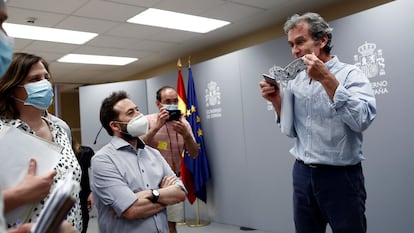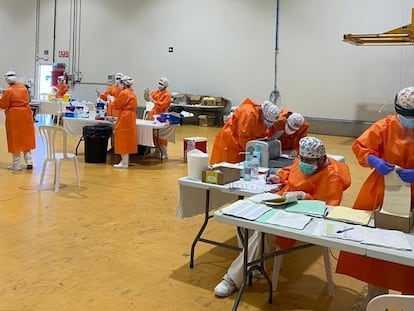Spain reports 12 active coronavirus outbreaks
The most concerning situation is in Aragón where a spike of infections among fruit pickers has forced three ‘comarcas’ to return to Phase 2 of the deescalation plan

Twelve of the 36 coronavirus outbreaks detected in Spain since May 11, when a new reporting system was introduced, remain active. That’s according to Fernando Simón, the director of the Health Ministry’s Coordination Center for Health Alerts. For the first time in nearly three and a half months, Simón, who has been one of the most visible faces of the government during the crisis, appeared in person at a press conference on Monday.
“Things are going well. I like seeing you instead of a blank wall with a camera,” he said to a room full of journalists at the Spanish Health Ministry.
On Sunday, Spain emerged from the state of alarm after nearly 100 days and entered the so-called “new normality.” “The new normality implies that we have to worry about outbreaks,” said Simón on Monday, adding that the situation is fluid. “Tomorrow there could be nine or 13 [outbreaks].”
Although there are outbreaks, it is difficult for the speed of transmission to be like it was before. Now we are detecting more quickly: 24 to 48 hours after symptoms beginFernando Simón, the director of the Health Ministry’s Coordination Center for Health Alerts
Of the dozen active outbreaks, two are in Andalusia, two in the Basque Country, and the rest have been detected in the Canary Islands, Castilla-La Mancha, Catalonia, Murcia, Castilla y León, Galicia, Navarre and Aragón. In the region of Aragón, nearly 68,000 residents of three comarcas – administrative divisions smaller than a province – are back in Phase 2 of Spain’s deescalation plan due to fresh outbreaks of the coronavirus. The most concerning outbreak has been detected among fruit pickers in Huesca province, with authorities rushing to track down all the contacts of the positive cases.
With the exception of one outbreak in Andalusia, which has been detected in a senior care home, most of the cases do not represent a threat to at-risk communities. “In Aragón, they are young workers who are healthy, no one has needed intensive care,” explained Simón, who added that the average age of coronavirus patients has fallen from 62 to 50 in one month. “This means that we are seeing a much less severe disease,” he said.
Although the origin of some coronavirus cases is still unknown, most new infections are connected with the outbreaks. “They are going to be a threat throughout this period, both local and imported [cases],” said Simón.
The last time Simón appeared before journalists at the Health Ministry, on March 11, he said the pandemic would last between two and five months. More than two months have passed since then, and there is just a month and a half before the pandemic reaches the five-month deadline. According to Simón, it is unlikely that the virus will be completely eradicated from Spain by this deadline, but he said the country was on a positive path.
“We have better detection capacity, better knowledge, we understand how the virus behaves,” he explained. “Although there are outbreaks, it is difficult for the speed of transmission to be like it was before. Now we are detecting [cases] more quickly: 24 to 48 hours after symptoms begin; back then it was 10 or 15 days. We are better prepared. I’m not saying that things can’t happen, but it is more difficult for them to.”
One of the biggest challenges continues to be imported cases, in other words people who were infected in another country and who traveled to Spain carrying the virus. Spain reopened its borders to European Union and Schengen-area countries on Sunday, and will loosen travel restrictions for tourists outside the EU from July 1. On how to contain imported cases, Simón said that it would be logistically challenging and not useful to test all tourists who arrive in the country, given that “they could develop the disease after” their arrival.
“We need to be disease-free but we also need to eat every day, and Spain lives from tourism,” he said.
Simón also spoke about the Moroccan government’s decision to suspend Operation Gibraltar Passage (OPE), which regulates the entry of 3.5 million Moroccan passengers and 800,000 vehicles from Europe into the country. “They have done us a favor with this measure, because having thousands of people in Algeciras waiting to board a ship [to Morocco] was a risky situation.”
Latest figures
According to the Health Ministry report released on Monday, 125 infections were detected in the previous 24 hours. In the past seven days, 21 coronavirus-related deaths were reported and there were 10 new intensive care admissions and 150 new hospitalizations. These figures are a little higher than those reported in previous dates, when hospital admissions fell below 100. Simón, however, said the overall trend is of a “slow decline.” Now that the state of alarm has come to an end, the figures on the coronavirus outbreak in Spain will be released twice a week, instead of daily.
English version by Melissa Kitson.
Tu suscripción se está usando en otro dispositivo
¿Quieres añadir otro usuario a tu suscripción?
Si continúas leyendo en este dispositivo, no se podrá leer en el otro.
FlechaTu suscripción se está usando en otro dispositivo y solo puedes acceder a EL PAÍS desde un dispositivo a la vez.
Si quieres compartir tu cuenta, cambia tu suscripción a la modalidad Premium, así podrás añadir otro usuario. Cada uno accederá con su propia cuenta de email, lo que os permitirá personalizar vuestra experiencia en EL PAÍS.
¿Tienes una suscripción de empresa? Accede aquí para contratar más cuentas.
En el caso de no saber quién está usando tu cuenta, te recomendamos cambiar tu contraseña aquí.
Si decides continuar compartiendo tu cuenta, este mensaje se mostrará en tu dispositivo y en el de la otra persona que está usando tu cuenta de forma indefinida, afectando a tu experiencia de lectura. Puedes consultar aquí los términos y condiciones de la suscripción digital.
More information
Últimas noticias
Most viewed
- Reinhard Genzel, Nobel laureate in physics: ‘One-minute videos will never give you the truth’
- Oona Chaplin: ‘I told James Cameron that I was living in a treehouse and starting a permaculture project with a friend’
- Pablo Escobar’s hippos: A serious environmental problem, 40 years on
- Why we lost the habit of sleeping in two segments and how that changed our sense of time
- Chevy Chase, the beloved comedian who was a monster off camera: ‘Not everyone hated him, just the people who’ve worked with him’











































